Do-it-yourself cleaning of split systems: preventive inspection and care of equipment
Regular and correct cleaning of split systems will increase their reliable operation and maintain functionality in all operating modes. But not only that.A clean air conditioner successfully combats harmful pollutants that are present in the air of residential premises.
We will talk about how to clean climate control equipment, which can be done independently. The article we presented describes in detail the process of disassembling the system to remove contaminants and options for processing functional components. Taking into account our tips, you can clean the unit without difficulty.
The content of the article:
Inspecting equipment before cleaning
We will consider the procedure for cleaning climate control devices, step-by-step instructions for their implementation and useful tips using the example of the most popular type of home and office wall split systems.
Before you start cleaning the split system yourself, you need to carefully inspect it externally, focusing on the following points:
- no damage to the current-carrying wires of the electrical circuit, their insulation and grounding;
- reliability of fastening of all screws in threaded connections;
- integrity of the freon circuit;
- no mechanical damage.
Such inspections of climate control equipment do not take much time, and it is recommended to carry them out not only before servicing the air conditioner, but also on a regular basis, at least twice a month.

In addition to periodic cleaning and split system maintenance, with certain symptoms based on the inspection results, there may be a need for unscheduled maintenance of the unit.
Signs of excessive contamination of the split system include:
- a characteristic unpleasant odor immediately after turning on the device;
- leaks from the housing of the indoor module;
- the appearance of an unusual sound during operation, extraneous crackling or increased noise;
- change in air temperature.
During routine maintenance of the system or to treat the indicated symptoms, it is necessary to perform all cleaning procedures in a certain step-by-step sequence, the result of which will be a device cleaned of all contaminants and operating stably.
Based on the number of main units of the split system, the cleaning procedure can also be divided into two stages: caring for the indoor unit and cleaning the outdoor module.
Disassembling and cleaning the indoor unit
The process of washing parts of split system units does not need a very detailed description. We will dwell on some of the nuances of this procedure below.

In order to have a general idea of what parts and assemblies internal wall module Split systems are subject to maintenance; you need to know its structure.
The main components of the indoor unit include:
- An evaporator, also known as a radiator or heat exchanger.
- Shaft or impeller.
- A motor that drives the shaft into rotation.
- Drainage tray/bath.
- Horizontal and vertical blinds.
- Control unit with temperature sensors and indicators.
- Mesh filters.
- The housing of the internal module, into which all parts are compactly built.
Careful familiarization with the structure of the indoor unit makes it possible to approach the cleaning procedures with understanding, and also after their completion, install all the parts in the right order in their places, carefully and correctly making the connection.
Step No. 1 - cleaning the air conditioner filters
The first step when servicing a split system is to clean the filtration elements.
The main section with upper filters, whose operating principle is based on a static effect, is located under the cover of the device. Cleaning them is the simplest procedure that does not require special knowledge and skills, and is also not too time-consuming.
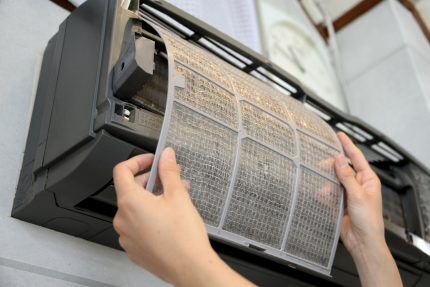
It is necessary to understand that even a slight accumulation of dust and grease deposits on the filters can create problems in the functioning of the entire device.
The procedure for servicing primary filters is as follows:
- Disconnect the device and wait at least 10 minutes.
- Unfasten the latches (usually on the side of the device) and open the outer cover.
- Remove the filter mesh sections attached to the frame.
The sides of the filter sections, placed under the housing and mounted on skids, are easy to remove.

In order to remove an additional filter, usually a sponge, you need to remove the air ionizer if the split system is equipped with one. Typically, the ionizer is mounted on the radiator on the control panel side of the device.
You just need to carefully pull the handle, and it will easily come out of the socket along the grooves. The filter is installed on the back of the ionizer on a plastic frame and can be easily removed from its grooves.
In case of heavy contamination, you can use a vacuum cleaner for preliminary cleaning. Then it is recommended to wash the filters and ionizer in a container with detergent, and then under running water. For washing, use a sponge and a soft brush.
Having completed the water procedures, all that remains is to shake off the moisture from the washed elements and lay them out to dry.
Step No. 2 - caring for the internal module
For further thorough cleaning of the entire air conditioner, it will be necessary to disassemble it, disconnecting and removing individual parts. This process is the most complex and time-consuming, especially if it is performed for the first time.
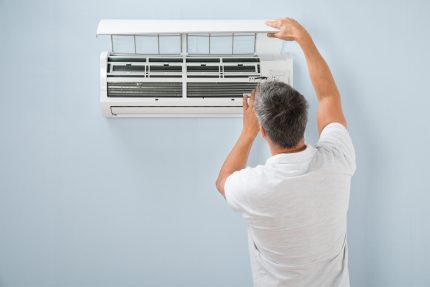
The first step is to detach the front part of the housing. The screws are located underneath the plugs. By pulling the cover towards you and up at the same time, it can easily be detached from the body.
Next, remove the tray to collect condensate.To do this, you need to unscrew the screw on the side fastening on the left of the housing and all the screws holding the damper drive and control unit on the right. When disconnecting the sensor, you must be careful and under no circumstances pull on the wires, but only on the retaining bracket.
After this, the drain pipe is disconnected. Despite the fact that filters do the main job of creating a barrier to dust, quite a large amount of dirt settles on the fan blades. Therefore, the need to clean the fan shaft is beyond doubt.
In order to remove the impeller, you must first unscrew, but not completely, the screw securing it from the side of the control panel. Since the shaft is removed along with the motor, it is necessary to remove the motor wires from the connectors. As a rule, there are two such connectors.
After this, you can remove the control unit from the electronic board. To prevent moisture from entering the electronic part of the module when washing, a plastic bag is placed on the unit, which is tightly tied and secured with tape.
The continuation of the process of removing the impeller is to disconnect the heat exchanger, for which the motor mounts from the housing and evaporator are unscrewed, as well as the screw holding the evaporator on the left side of the block.
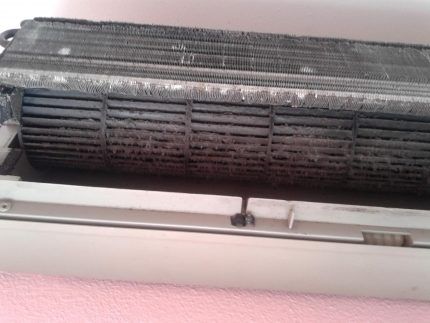
Completely disconnecting the indoor unit from the system connecting it to the outdoor compressor is a complex procedure and cannot be done at home. In addition, in this case, the entire system will need to be recharged with freon.
Therefore, it is enough to free the module from its attachment to the wall and carry out further cleaning procedures. For ease of operation, a rope is tied to the body of the block. With its help, it is hung on the brackets from which it was removed.
Having freed the evaporator, it will be easy to disconnect the block with the impeller and motor from the module itself and then send it to the sink.
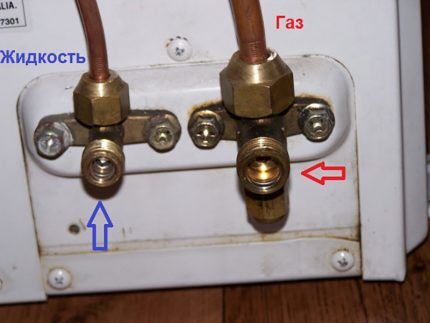
From this point on, further maintenance of the split system can be continued in two options:
- Dry removal of dust and dirt from the evaporator.
- Washing the heat exchanger using a spray method.
The first method involves cleaning the front of the heat exchanger with a vacuum cleaner and a brush. To clean the rear part, the heat exchanger is removed to a permissible distance from the wall and carefully vacuumed using a crevice nozzle.
Given the tight space, it is not recommended to use a brush or brush to clean the rear part of the evaporator, so as not to damage the radiator.
Along the way, you must remember to clean all accessible plastic areas of the case, as well as the back of the condensate drain tray, using cleaning wipes or a rag moistened with detergent. But even the highest quality dry cleaning of the heat exchanger will not give the effect achieved by washing it with water.
Step #3 - cleaning the evaporator
In order to wash out all the deposits that have accumulated there from the radiator and the air conditioner housing, it is necessary to first protect walls, furniture and floor coverings from splashes and flooding with water and cleaning agents.
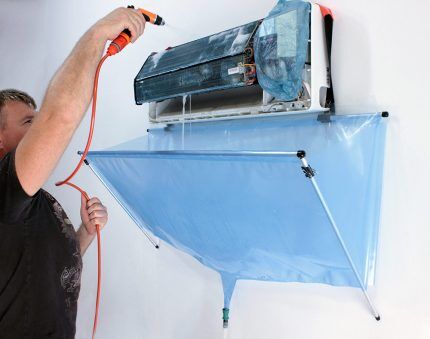
But it is quite possible to make such a device with your own hands. To do this, you need to stock up on film, tape and a container to collect water.
The installation procedure for homemade service protection is as follows:
- Prepare a plastic film of the required size: with a margin of at least 1 meter for the width of the air conditioner on both sides and taking into account the distance from the unit to the container in which waste water will be collected, you can use a regular bucket.
- Secure the top part of the film to the wall behind the air conditioner with tape.
- Collect the bottom of the film and place it in a bucket, cutting off the excess part and securing it with tape along the edge of the container.
All dirt along with water will be drained into a bucket through an equipped funnel, without causing damage to the room. The air conditioner is washed with a jet of water under pressure.
The following devices can be used for this:
- a hose from a water tap with a nozzle for creating a high-pressure jet;
- manual pump sprayer;
- Kärcher automobile apparatus.
Karcher, which creates high pressure, should be used with some caution.
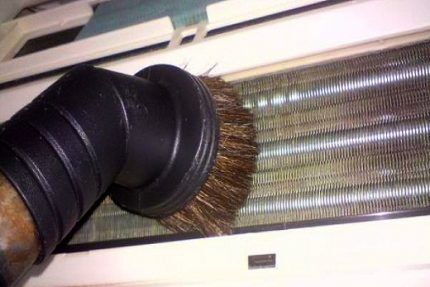
Assembling the indoor air conditioner module is carried out in the reverse order. When disassembling for the first time, it is recommended to record the entire process, leaving notes about the main actions on paper, or using video/photo shooting.
Care and accuracy in this matter will not lead to a situation in which after assembling the product, unnecessary parts will remain.
Maintenance of the external module of the split system
The main enemy of outdoor air conditioner units is street dust and poplar fluff. In the absence of timely maintenance, the condenser and compressor of this module, depending on the height of their location, will work effectively for no more than two to three seasons.
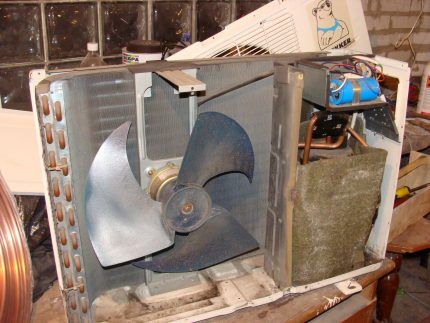
To properly service this module, you must also understand its design.
The outdoor unit includes:
- A fan that supplies air flow to the heat exchanger.
- A condenser, which is a system of copper tubes through which freon circulates.
- A compressor that compresses and circulates refrigerant through the system.
- A four-way valve that provides reverse operation of the split system, changing the roles of the condenser and evaporator.
- Filter.
As when working with the indoor unit, before starting the cleaning procedure of the outdoor module, you must make sure that the system is de-energized. At the first stage, all contaminants on the unit body are removed, after which the front panel is dismantled and you can begin cleaning from the inside.
Step by step it looks like this:
- Remove the grille and fan.
- Protect the engine from moisture by hiding it as tightly as possible in a plastic bag.
- Dry clean accessible areas of the internal system of the device using a paint brush.
- Use detergent to clean all internal parts of the module that are accessible when the front is open, as well as where possible - on the outside, on the sides and at the back.
- After waiting 5-10 minutes, wash all components in the same way as described for the indoor unit.
- Install all removed parts in reverse order.
It should be remembered that cleaning the radiator of the internal module must also be done with care so as not to bend or damage its fins.
During cleaning compressor-condensing unit It is advisable to inspect its components. It is important to identify in a timely manner Compressor malfunctionsto troubleshoot problems immediately. Our recommended article will introduce you to the rules of diagnostics.

It is important not only to understand in what sequence and how to clean the components of split systems in normal home conditions, but also not to violate basic safety measures.
All contacts with internal components of the system are allowed only when the device is de-energized, and when working at height, it is necessary to provide insurance and exercise maximum caution.
Cleaning the drainage outlet
Aggregate changes in the state of the refrigerant inevitably lead to the formation of condensate. Accumulating in the indoor unit, water is discharged through a special drainage pipeline into the outdoor module, from where it flows down.
Clogging of the drainage pipeline and, as a result, lack of free removal of water can cause indoor unit leakage while the device is operating. Often, the causes of clogged drainage systems can be not only deposits that have arisen during the operation of the device, but also, for example, a plug from a nest made by wasps.
The procedure for cleaning the drainage of a wall-mounted split system is quite feasible to do with your own hands, without extra costs for the services of specialists.Above, in the instructions for disassembling the indoor unit, it was described how to disconnect the condensate drain tray from the drain tube.
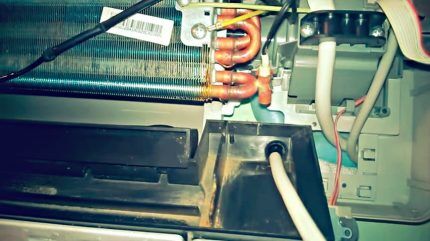
Next, to better clean the drainage and treat it at home, you can do the following procedure:
- Fill the system with a disinfectant, such as hospital-grade chlorhexidine, approximately 4 bottles.
- Wait at least 15 minutes, connect a vacuum cleaner hose to the drainage tube and suck out all deposits.
If you don’t have a pump, you can pump in disinfectant manually using a plastic bottle, which you need to connect with a rubber tube and a hose to a drainage hole. By raising the container above the level of the drainage inlet, the liquid is pumped into the system using simple compressions.
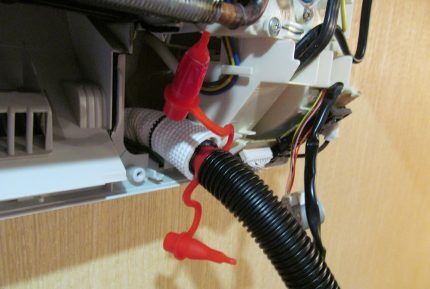
With different diameters of the drainage hole and air injection device, you can make an adapter. With a little imagination, this is not difficult to do at home using available materials.
Antibacterial treatment of equipment
Mandatory at the final stage of servicing the split system will be the procedure for treating all parts with antifungal agents and antibacterial compounds acceptable for spraying in a residential area.
To neutralize the air conditioner from germs and various microorganisms, the following can be used:
- compositions containing antibacterial agents;
- special cleaners for air conditioning systems;
- products containing chlorine-containing substances.
The safest option when choosing a disinfectant would be preparations used to disinfect medical instruments.
Disinfection is recommended to be carried out after full maintenance and drying of the split system parts, before its assembly.
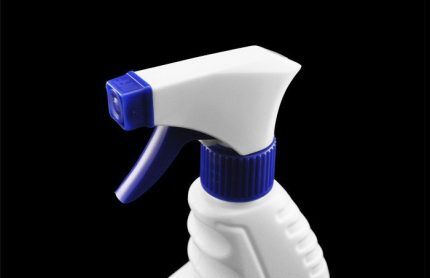
Often, simple clogging causes a decrease in the cooling capacity of climate control equipment. A complete list of reasons for malfunctioning of the unit is presented in next article, which we highly recommend reading.
Conclusions and useful video on the topic
Tips for disassembling, servicing and assembling the indoor unit of an air conditioner from a specialist:
Do-it-yourself disassembly and cleaning of the external air conditioner module:
A mechanical method for removing a plug in the drainage pipeline of an air conditioner, the formation of which was caused by a wasp’s nest:
It should be understood that the need to invite specialists to repair it depends on how regularly the split system is cleaned. But not only that.
The given tips for self-service of the air conditioner will provide practical assistance in keeping it constantly clean, and this is a guarantee of protection against unwanted health consequences in the comfort zone.
Would you like to talk about how you cleaned your own or office split system yourself? Do you have useful information that could make the cleaning process easier for site visitors? Please write comments in the block below, post photographs, and ask questions about the topic of the article.




Yes, you still can’t clean it yourself the way professionals clean it. Whatever you say, they have industrial vacuum cleaners and steam generators, and they can refuel them in case of a leak. Of course, anyone can clean the upper filters and rinse them with water; there is nothing complicated there. But it’s better not to get into the indoor unit if you don’t understand it. And the outdoor unit is generally inconvenient to clean, especially if you live above the third floor. In general, I didn’t trust my husband with this.
Cleaning the air conditioner is very important, as it accumulates a large amount of dust and harmful microorganisms. I ask my husband to remove the filter and clean it at least once a month. The very first time we turned to the Internet for help, we found a similar air conditioner on YouTube and watched the video. After viewing, it became clear where the plugs and screws are located in our air conditioner. In general, the process is not complicated, the main thing is to be careful about the details.